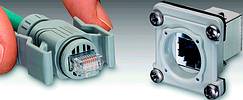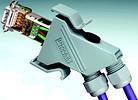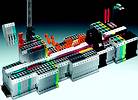
Advancing industrial automation demands ever more complex controllers that can process more signals and visualise and report industrial plant statuses via different channels. The large number of electrically transmitted signals requires an efficient connection technology so that setting up and maintaining a facility can stay as simple as possible.
Also, the production of individual electronic components such as controllers and I/O components has to be organised cost-effectively.
Ordeal by fire for plug connectors
A significant step towards cost-effective electronic component manufacturing is SMD (surface mounting device) technology. Its advantage is automatic placing of components, which allows for efficient production. For electronic components, such as integrated circuits and resistors, this placment method has become the norm. Components that have either large dimensions or a high own weight still need to be placed manually and then wave-soldered or even hand-soldered. This also applies to many PCB plug connectors which, because of the high mechanical strains of inserting and removing the plug, cannot be surface-soldered.
With through hole reflow (THR) technology, the plug connectors are placed on the PCB in through-plated holes as before, and then soldered like SMT components in the reflow oven. This method eliminates additional process steps. To use all the advantages of SMD technology, the plug connectors need to be fully integrated into the standard production process. This means applying the soldering paste, automated placing and soldering in the reflow oven. The solder paste is applied using the screen printing process. When designing the plug connector, it has to be ensured that the usual paste thickness of about 150 µm is sufficient for perfect soldering. For the plug connector to be used in standard pick-and-place machines, it needs a smooth pick-up surface for the vacuum pipette and suitable packaging. The insulator has to be made of high temperature resistant plastic that can withstand the temperatures of up to 260°C that occur in the reflow oven. The design of the plug connector has to ensure that the radiated heat from the oven reaches the soldering points unimpeded.
The design and machine-suitable packaging - ie, tape-on-reel and tube feeder - of Phoenix Contact's Combicon PCB plug connectors enables them as THR variants to have all the advantages of SMT production. They can be handled with standard SMT production equipment and thus placed on the PCB at the same time as the SMT components and reflow-soldered (see Figure 1).

Industry goes Ethernet
The various statuses of industrial installations are increasingly being reported to control rooms via Ethernet and Internet. Because these networks were initially only used in office buildings, the accompanying plug connectors are designed only for use in protected areas. For using standardised data plug connectors in harsh industrial environments, Phoenix Contact offers the Variosub product family. Variosub RJ45 plug connectors to protection category IP67 enable waterproof device connections to Ethernet networks. They also assemble in exactly the same way as their virtually unprotected office counterparts. This has the advantage that existing tools for network cabling, and even ready-made patch cables, can continue to be used (see Figure 2).

The Variosub-Bus plug is available for waterproof connections to various fieldbuses such as Profibus, CANopen and Interbus, and uses standard D-SUB inserts for contacting. All Variosub versions offer simple push-pull locking to the device and are quick to lock and unlock without requiring tools (see Figure 3).

Long live the control cabinet
Despite the progress in networking and data transmission using serial fieldbuses, plant engineering cannot yet do without the control cabinet. Here too, a quick and efficient connection technology is in demand, for instance to simplify maintenance work.
The pluggable ST-Combi terminal blocks are specially suited to flexibly wiring signals from the field. On the control cabinet side, they offer space-saving spring-cage connectors. On the field side, a powerful plug connector that can carry currents up to 24 A. Accessories such as strain reliefs, locking devices and - important in EMC-contaminated industrial environments - connectors for the cable screen, complete the range. Thus, secure signal and power transmission is possible with pluggability as well. Thanks to the universal accessory system, the terminals in this product range can be combined with spring cage terminals in the ST product family without additional expense. Universal shafts for bridge plugs, for example, enable easy potential distribution and jumpering (see Figure 4).

Conclusion
Sophisticated electrical connection technology helps reduce costs in the production of electronic devices and in the operation and maintenance of facilities. Furthermore, it cuts set-up and service times and as far as possible prevents failure through misoperation.
For more information contact Rob MacKenzie, Phoenix Contact, 011 793 7121.
| Tel: | +27 11 801 8200 |
| Email: | [email protected] |
| www: | www.phoenixcontact.co.za |
| Articles: | More information and articles about Phoenix Contact |

© Technews Publishing (Pty) Ltd | All Rights Reserved